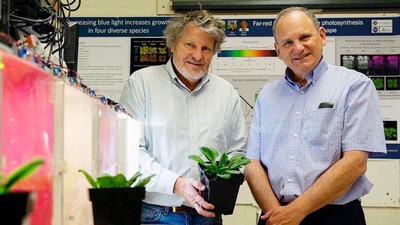Utah State Magazine Excerpt: Unraveling the Universe with Lara Anderson
USU alumna Lara Anderson is unraveling the secrets of string theory. (Laura Schaposnik photo)
This is an excerpt from Utah State Magazine's Spring 2022 edition, out now, with the theme "Tiny Things, Big Impact." The full article is available on the magazine's website, utahstatemagazine.usu.edu.
Theoretical physicist Lara Anderson ’03, M.S. ’04 is flying.
Her mind and ballpoint pen are moving at what seem to be the speed of light.
A blustery November day finds this Rhodes Scholar and associate professor at Virginia Tech teaching in the sleek metal and glass New Classroom Building, tearing through equation after equation related to coupled oscillation on an overhead projector.
“The game plan is we’re going to try to plug in z, which I’m going to define as the set of coefficients A1, A2, e to the i omega t,” says Anderson to the assembled juniors and seniors. “Write that as a vector — e to the i omega t. I want to plug that into my matrix equation, and x double dot is minus k x.”
Some people have big ambitions. Anderson’s are small. Super small. Her field of interest — string theory — burrows the mind down to the most infinitesimally minute iotas of reality. It holds the promise of unifying incompatibilities between Einstein’s theory of General Relativity and quantum mechanics in a framework that governs all forces and all matter.
As Anderson tells it, one-dimensional strings, not atoms, are nature’s fundamental building blocks. They are a millionth of a billionth of a billionth of a billionth of a centimeter long, so tiny that if an atom were enlarged to the size of our solar system, a string would be as tall as a telephone pole.
One more thing — strings are weird. Imagine an ultrasubmicroscopic party hosted by Timothy Leary, narrated by Dr. Seuss, and drawn by M.C. Escher. Strings can be matter or energy, depending on how furiously they vibrate. Strings nestle inside other small thingamajigs — shapeshifting donutoidal entities called Calabi-Yau manifolds. These have dimensions beyond length, width, and depth. Maybe 10. Maybe more. It is all unimaginably unimaginable — at least to the minds of non-physicists.
“String theory miraculously overcomes 100-year-old problems of quantum gravity,” says Anderson, who, not surprisingly, was class valedictorian.
CONTACT
Kristen Munson
Managing Editor
Utah State Magazine
kristen.munson@usu.edu
TOPICS
Alumni 181stories Physics 99stories Mathematics 44storiesComments and questions regarding this article may be directed to the contact person listed on this page.







